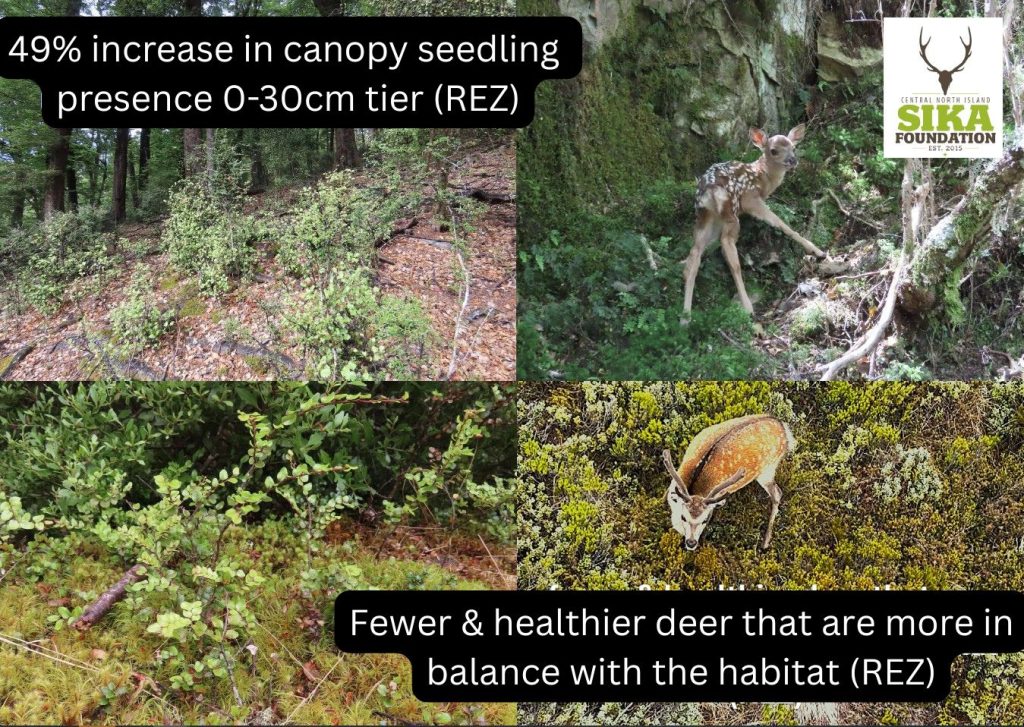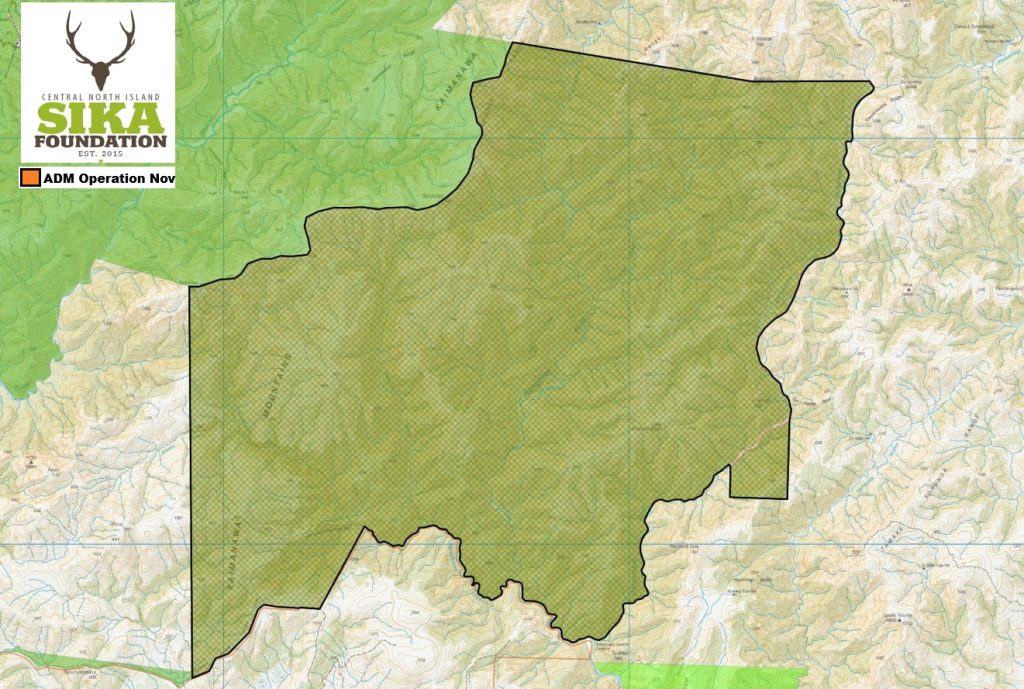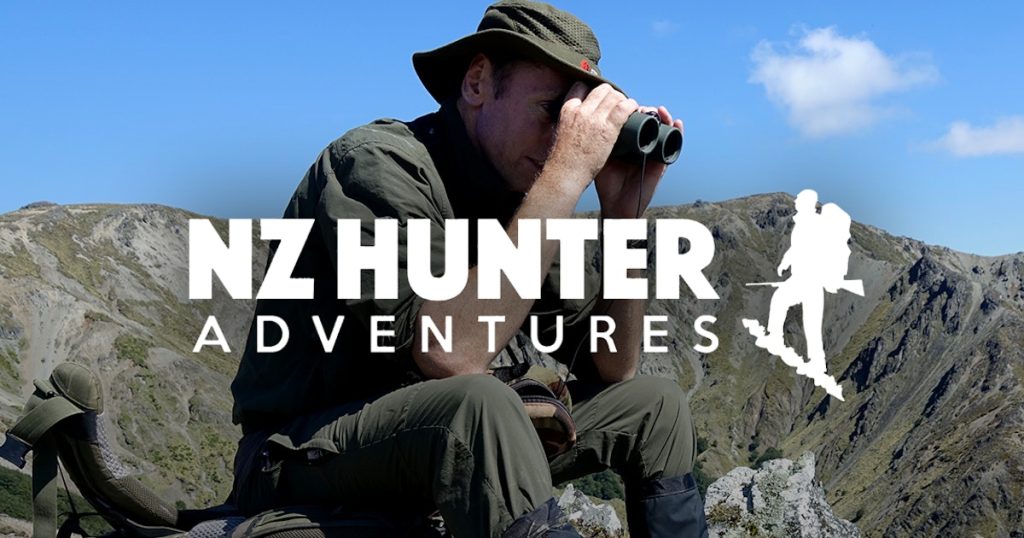Working strongly in collaboration with and enabled by further funding from DOC, The Sika Foundation continues its Adaptive Deer Management & Research Plan Kaimanawa & Kaweka 2022 – 2025. The Kaimanawa Remote Experience Zone (REZ) ADM&R plan – 2024 Report shows that the herd health has improved, with fewer and healthier animals more in balance with the habitat.
While herd health improves quickly, it is recognised that maintaining management and monitoring the habitat is critical to ensure deer densities are kept at appropriate levels, to ensure canopy replacement following natural canopy collapse.

For 2025/26 there will be:
• November 2025: another hind focused thermal assisted aerial operation in the REZ.

Click here for a detailed map of the REZ operational area (PDF)
• Late November 2025: a thermal assisted survey of the true left Waipakihi mountain beech habitat, to capture and socialise deer location/densities that are impacting mountain beech canopy replacement observed with similar “die back” habitat to the REZ.

Click here for a detailed map of the Waipakihi survey area (PDF)
Previous deer management operations associated with the Kaweka Mountain Beech Project ran from 1998 to 2016. Since then, poor herd health indicators have increasingly been observed with little mountain beech seedling/sapling presence being documented in the 2024’s seedling ratio index monitoring. The Sika Foundation is currently in a planning and engagement phase regarding the timing for the Kaweka North operation.

Click here for a detailed map of the Kaweka North operational area (PDF)
FAQs
For how long?
In collaboration with DOC, sustained annual adaptive deer management operations will be required for initial “knock down”. Eventually operations will be able to shift into a less intensive “maintenance” phase that still ensure densities are maintained at levels that ensure canopy replacement occurs following natural canopy collapse.
When is it happening?
REZ operations will be from late October through till the 30th of November 2025. WPK survey will be in late November. The Sika Foundation is currently in a planning and engagement phase regarding the timing for the Kaweka North operation.
What is being shot? Will it be hinds only?
The Kaweka North operations will only be targeting hinds.
The REZ operation will continue to target hinds, and stags of poor quality.
How will you know when enough hinds have been removed?
In collaboration with DOC, monitoring vegetation through seedling ratio index. More in depth “long term forest structure” methods will also be implemented to ensure densities are at levels that allow canopy replacement to occur following natural canopy collapse.
Can I book, stay in, or use the huts/tracks in the operational area?
Yes, there will also be “buffer zones” put in place for tracks, huts and structures to ensure operators are aware of all potential user group activity in the operational area.
Will I be safe?
Yes, operations will check in with bookings before operations commence. operations are in line with DOC best practices with strict protocols in place. If any park users are encountered, operators will leave the immediate area and operate elsewhere.
What time of the day will the shooting take place?
Generally, mornings and evenings, however operations may be during the day if conditions allow.
What is the interval of the Vegetation Monitoring?
In collaboration with DOC, SRI/FPI monitoring has been conducted (and is proposed to continue) at a 3-4 year rotation for management units measured as a part of Sika Foundations Adaptive Deer Management & Research Plan Kaimanawa & Kaweka 2022 – 2025 | DOC and Sika Foundation will work together on monitoring plans moving forward.
Will the vegetation data be publicised?
In collaboration with DOC, parts or all of monitoring technical reports may be shared in annual reporting or publications.
Will maps showing where hinds have been shot and stags sighted be made freely available to interested parties and in a timely manner?
The REZ kill and stag detections/WPK survey locations/detections will be mapped out for socialisation in a timely manner (Feb 2026) as a part of the 2025 annual report, also containing more in-depth detail for all deer management and monitoring operations.
Will any deer be recovered for jaws or meat?
The Sika Foundation will contribute financially for a budget to recover animals (when and where possible) for autopsy, (jaw, condition scores, weight and reproductive status) to contribute to Sika Foundations Jaw and data programme. Any meat recovered will be utilised either to local iwi or the mince for foodbank programme.
What are the benefits to the environment?
Managing deer densities (in particular, targeting sika hind matriarchal family groups living in discreet home ranges) decreases the impacts on the habitat “at place” to ensure canopy replacement will occur following natural canopy collapse.
What are the benefits for hunting?
lower density deer herds more in balance with the habitat, with a higher proportion of males produce;
- improved herd health indicators (condition, reproductive rates, skeletal size)
- A higher proportion of young (naïve) animals available for harvest
- Higher quality venison
- Higher quality stags
- More intense rutting activity due to the competition between stags for fewer better condition hinds that cycle annually.
See this NZ hunter episode, highlighting current poor habitat and herd health in the core of the KWN management unit (28mins onwards).

